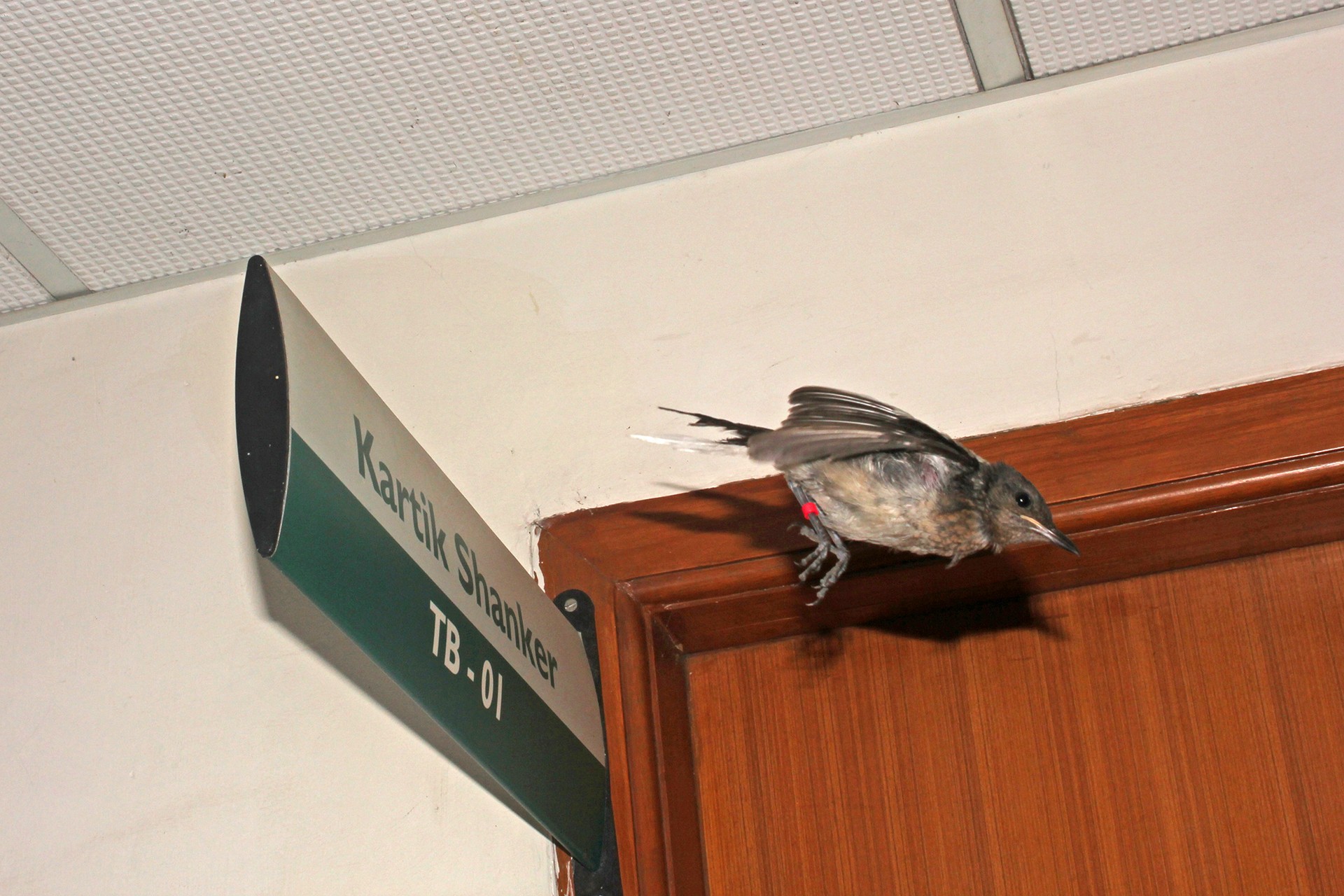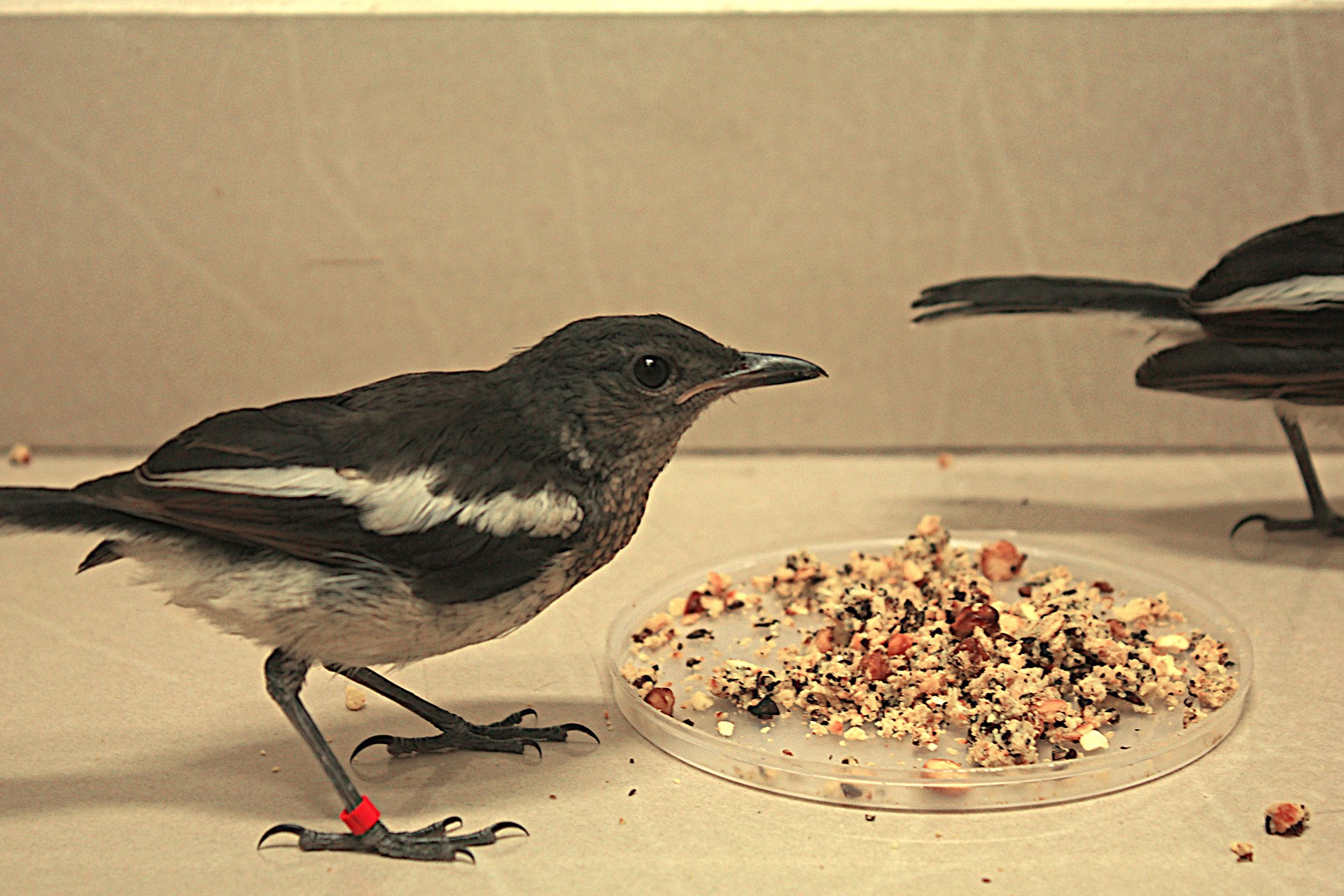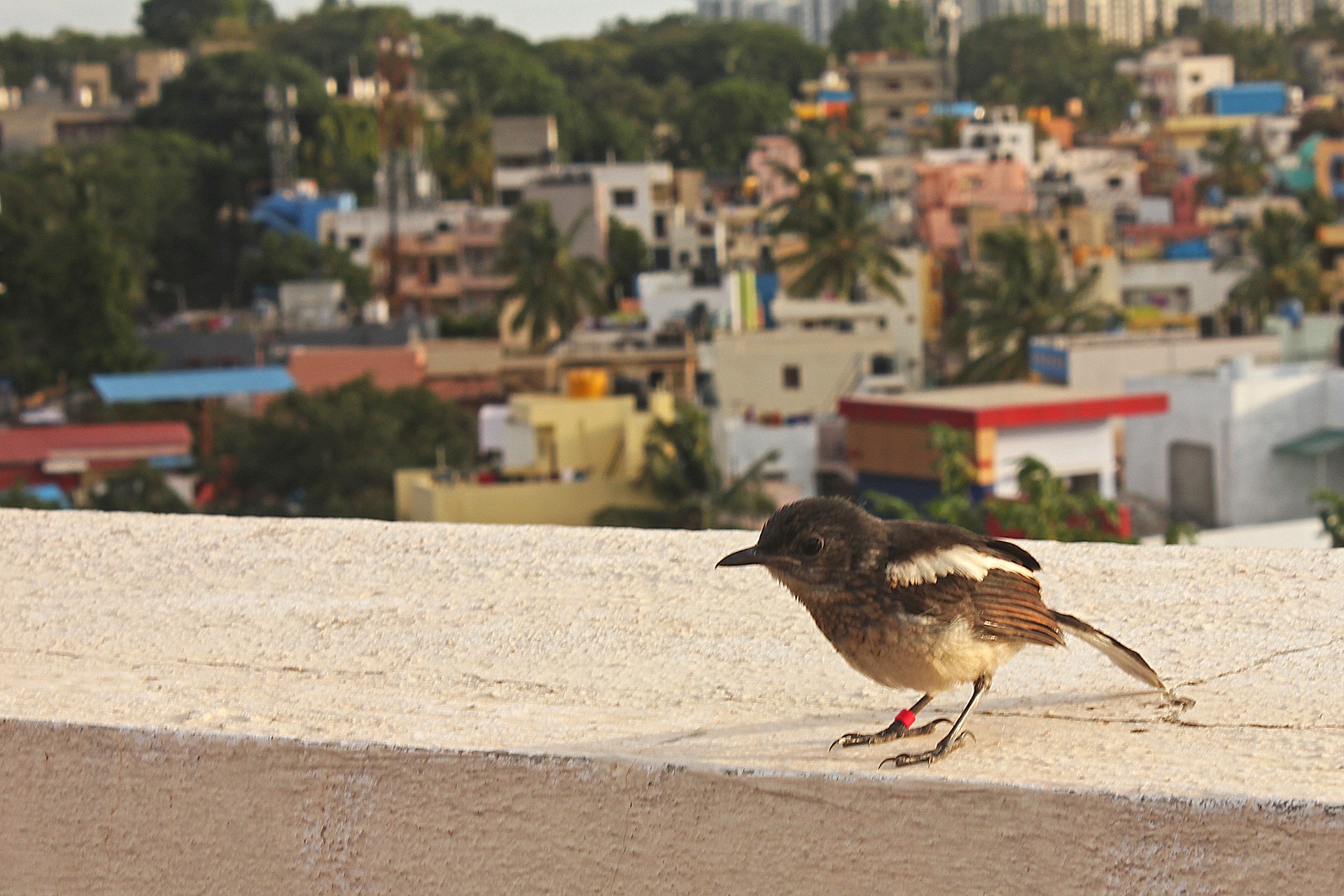It was a beautiful Thursday. The weekend was in sight, and I was already looking forward to laidback lunches and potluck suppers with my friends. Little did I know that for the next three months my social life would be virtually nonexistent. I would be working every day and every hour – as a full-time parent and teacher, if you will.
I am a doctorate student at the Centre for Ecological Sciences, Indian Institute of Science, in Bangalore. I was at work early that day when the office phone rang. Somebody from the institute had found birds being attacked by Large-billed Crows (Corvus macrorhynchos). I rushed to the rescue on my cycle, finding not one but four Oriental Magpie-robin chicks (Copsychus saularis) scared and sitting in a corner, with the building watchman standing guard over them.
I quickly brought them back to the lab, where they would be safe from the crows, and examined them for wounds. They were scared and weak and shied away to one corner of the cardboard box I had placed them in. The birds didn’t accept any food or water that first day. I knew that the first few days of a rescue are always difficult as the birds are stressed and it takes time to make them feel safe, but I was still unsure about what to do.
The next day, I woke up early and went hunting for small lizards (Cnemaspis and hemidactylus species) and other critters, as I had observed magpie robins in the wild feeding on lizards and cockroaches. After two hours of hunting I found six lizards. The magpie robins were quite hungry by the time I returned – I could hear quiet Chirrrrr-Chirrrrrs from the box. That’s the call these chicks make when their parents bring food to the nest, or when they are hungry. I lifted up the lid and dangled a lizard towards them. One chick opened its mouth; it was still scared but it devoured the whole lizard in no time. Soon, the others followed and their beaks scarcely ceased to close. The chicks had fledged when I found them, but they still weren’t able to fly properly – their tails were tiny and they would spend most of their day sleeping. Still, I had to feed them every half hour. Their diet consisted mainly of boiled eggs mashed with channa, or lizards and insects.
Two weeks went by. They began to emerge from the box but were still not flying much. For the most part, they would stick to each other and sleep. I had to be in the lab from 8am to 6pm, as the chicks needed to be fed often. If I was late in feeding them, they would call incessantly and my lab mates would get disturbed, so I had to be extra careful to maintain peace in the lab. By then, my lizard-catching skills had improved; I could catch twenty or thirty in less than thirty minutes. The babies were healthy now, and one day they suddenly started flying around. They refused to sit in the box any longer, and they would flutter all around the lab, sometimes pooping on my colleague’s desks, sometimes on their laptops. My days were spent feeding the chicks and cleaning after them.
By the fourth week, the magpie chicks had become more vocal. They would chirp continuously among themselves, and when they were hungry, they would come chirp near me. I began to whistle to them to call them near me so that I could feed them. My repertoire of whistles grew. A sharp pheeeeoooo, and they would immediately respond with a chirr-chirrrr. A phewoooo-pheooo-phooo-pheoo would mean ‘come quickly, I have lizards’. A harsh Krhhhhh would signal danger. Soon, we could understand and communicate with each other very efficiently.
Since they were able to fly well by then, and had begun to drink water by themselves, I thought it would be a good idea to take them out in the woods so that they could start becoming independent. On their first day out, I took all four of them to a secluded wooded patch near my department and released them. They seemed excited, hopping all around the bushes and exploring the habitat. They were out for almost half a day but were unsuccessful in finding food. I stood guard the whole time, shooing away any crows in the vicinity. The chicks kept coming to me and begging for food. I had brought mashed boiled egg with me and would feed them small bits when they came down from the bushes to feed. In the evening I brought them back to the lab.
The next day, I left them in the same spot without any supervision but went to check on them every two hours. That evening it rained and there was a hailstorm. I went out to find the chicks as soon as the rain stopped, but there was no sign of them – not a chirp or a whistle. I was scared and imagined the worst, but just at that moment, one chick came out from the bush chirping away, and the others followed. Another day in the wild was over, and my babies were alive and safe.
This became a daily routine. I would drop them to their ‘school’, the woods, early in the morning, and in the evening, I would go singing and whistling to call them back. They were learning fast. I would give them half-dead grasshoppers to practice their hunting skills. They would sally in the air and catch flies. Day by day, they were becoming more confident and exploring more and more of their territory. I had become more confident about their survival in the wild too, so I began releasing them straight from my third-floor window. They were quick to figure out the exact position of the window, and in a day or two, they also figured out how to come to the lab door, and eventually inside the lab, to their safe roosting place.
The chicks were by now very bold and responsive – I would whistle and they would come flying straight into the balcony to feed from my hand. Sometimes they would follow me around and forage in the department corridors. All this was quite stressful for me because I had to constantly be on the lookout. If they entered other labs or if I heard Shikra (Accipiter badius) calls in the vicinity, I would go running to warn them with a harsh Krhhhh so that they learned to avoid predators.
Finally, after about two months of this routine, two of the chicks left and set out on their own. It felt as if something was amiss. I was a bit sad, but more happy that they made it. The other two still continue to come inside the lab to roost in the evening. We look into each other’s eyes and know exactly what we are thinking. They sing to me sometimes and the melodious songs are a soothing antidote to the hustle and bustle of the city. I whistle to them when they return in the evening, and they flap their wings and jump around me as if they are happy to see me. I often wonder how it’s going to feel when these two leave me too. As I type this, they are sitting on my chair behind me and making a harsh Krshhh call because they are irritated and want me to give them attention. I should probably go and give them some food.




